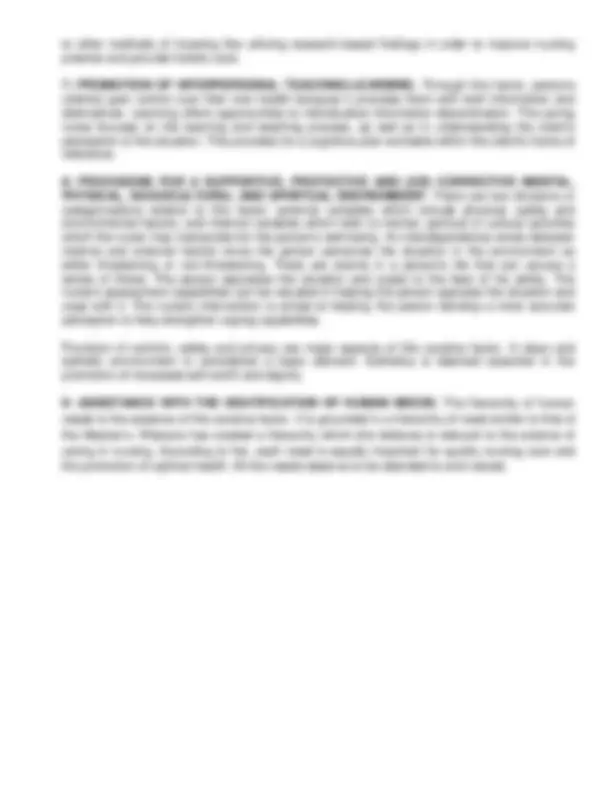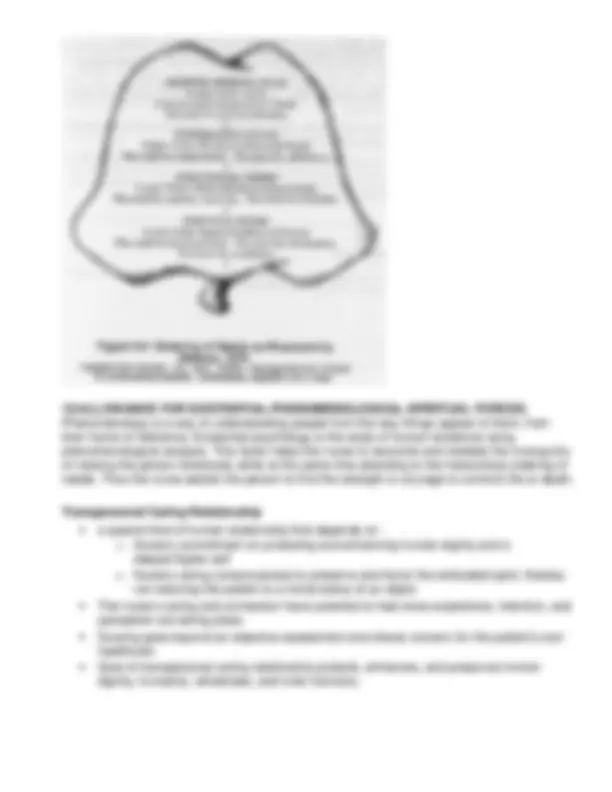





Study with the several resources on Docsity

Earn points by helping other students or get them with a premium plan


Prepare for your exams
Study with the several resources on Docsity

Earn points to download
Earn points by helping other students or get them with a premium plan
Community
Ask the community for help and clear up your study doubts
Discover the best universities in your country according to Docsity users
Free resources
Download our free guides on studying techniques, anxiety management strategies, and thesis advice from Docsity tutors
According to Watson, the first three carative factors provide the philosophical foundation. Page 2. for the science of caring. The remaining seven carative ...
Typology: Assignments
1 / 5

This page cannot be seen from the preview
Don't miss anything!




Human Being/Person
Health
Environment/society
Nursing
Watson viewed caring as the essence of nursing. Caring connotes responsiveness between the nurse and the person. The nurse co-participates with the person. The purpose of caring is to assist the person in gaining control and becoming knowledgeable, and in the process promote health changes. If we have thought of the concept of empowerment while reading this, yes, we can say that it is similar to that. By allowing the client to be knowledgeable, the nurse provides an environment for better decision-making, better self-control and, better self-respect. The concept is common to Filipino culture: “kakayahan" or "patibayin ang kakayahan," meaning assisting the person in gaining control.
While it is true that caring as an attribute in nursing has been described and clarified by many others, there is uniqueness in Watson's science of caring. Basic assumptions for the science of caring are supported by ten carative factors that provide structure to the concept of caring. According to Watson, the first three carative factors provide the philosophical foundation
for the science of caring. The remaining seven carative factors spring from the foundation laid by these first three.
Watson’s theory has 3 Major Conceptual Elements:
10 Carative Factors
1. FORMATION OF A HUMANISTIC-ALTRUISTIC VALUE SYSTEM. The value of altruism (regard for others as a personal action) is learned at an early age. It is a value shared with parents. One's own life experiences are learning opportunities to gain insights about dealing with others. Caring based on humanistic values and altruistic behavior "can be developed through examination of one's own views, beliefs, interactions with various cultures and personal growth experiences." This development is perceived necessary for the nurse's own maturation. 2. INSTALLATION OF FAITH-HOPE. This factor is deemed essential to both carative and curative processes. To nurses, this provides a basis for looking into the healing power of belief, or the spiritual dimension, when curing is not possible. The use of Faith-Hope as a nursing intervention allows nurses to explore alternative methods of healing, like meditation. It seems that the goal for this activity is the provision of a sense of wellbeing through belief systems that are meaningful to the client.
3: CULTIVATION OF SENSITIVITY TO SELF AND OTHERS. Nurses promote "health and higher level functioning only when they perform person-to-person relationships as opposed to manipulative relationships." There is a need for the nurse to develop and examine one's own feelings. Through this process, increased sensitivity to others is developed. The nurse becomes honest and promotes self-growth and self-actualization. Watson's premise further states "that at the highest level of nursing, the nurse's human care responses, human care transactions, and presence in the relationship transcend the physical material world." The explanation makes it clear that interactions between the nurse and the client deal with the person's emotional and subjective world as a means to learn the inner self
4: DEVELOPMENT OF A HELPING-TRUST RELATIONSHIP. Communication, both verbal and non-verbal, is a mode of accomplishing a helping-trust relationship to establish rapport and caring. Characteristics common to this carative factor are congruence, empathy, warmth and honesty. Positive acceptance of another is most often expressed by body language, touch and tone of voice. I'm sure that given your clinical experiences, you can think of many situations to relate to this fourth carative factor.
5: PROMOTION AND ACCEPTANCE OF THE EXPRESSION OF POSITIVE AND NEGATIVE FEELINGS. According to Watson, it is important to facilitate awareness of both negative and positive feelings to improve on one's level of awareness. Feelings need to be considered in a caring environment. Being aware of both positive and negative feelings leads to better understanding of behavior.
6: SYSTEMATIC USE OF THE SCIENTIFIC PROBLEM-SOLVING METHOD FOR DECISION MAKING. This factor gives notice to the limitations nurses have in assessing the issue of developing a scientific base because most of our time is dedicated to the performance of nursing tasks such as procedures and treatments. Thus, recognition is given to the use of the systematic problem-solving method in building nursing knowledge. In the same way, the argument extends
Phenomenology is a way of understanding people from the way things appear to them, from their frame of reference. Existential psychology is the study of human existence using phenomenological analysis. This factor helps the nurse to reconcile and mediate the incongruity of viewing the person holistically while at the same time attending to the hierarchical ordering of needs. Thus the nurse assists the person to find the strength or courage to confront life or death.
Transpersonal Caring Relationship
Caring Occasion/Moment Caring occasion is the moment when the nurse and another person come together in such a way that an occasion for human caring is created. Both persons come together in a human-human transaction. The one caring for and the one being cared for are influenced by the choices and actions decided within the relationship